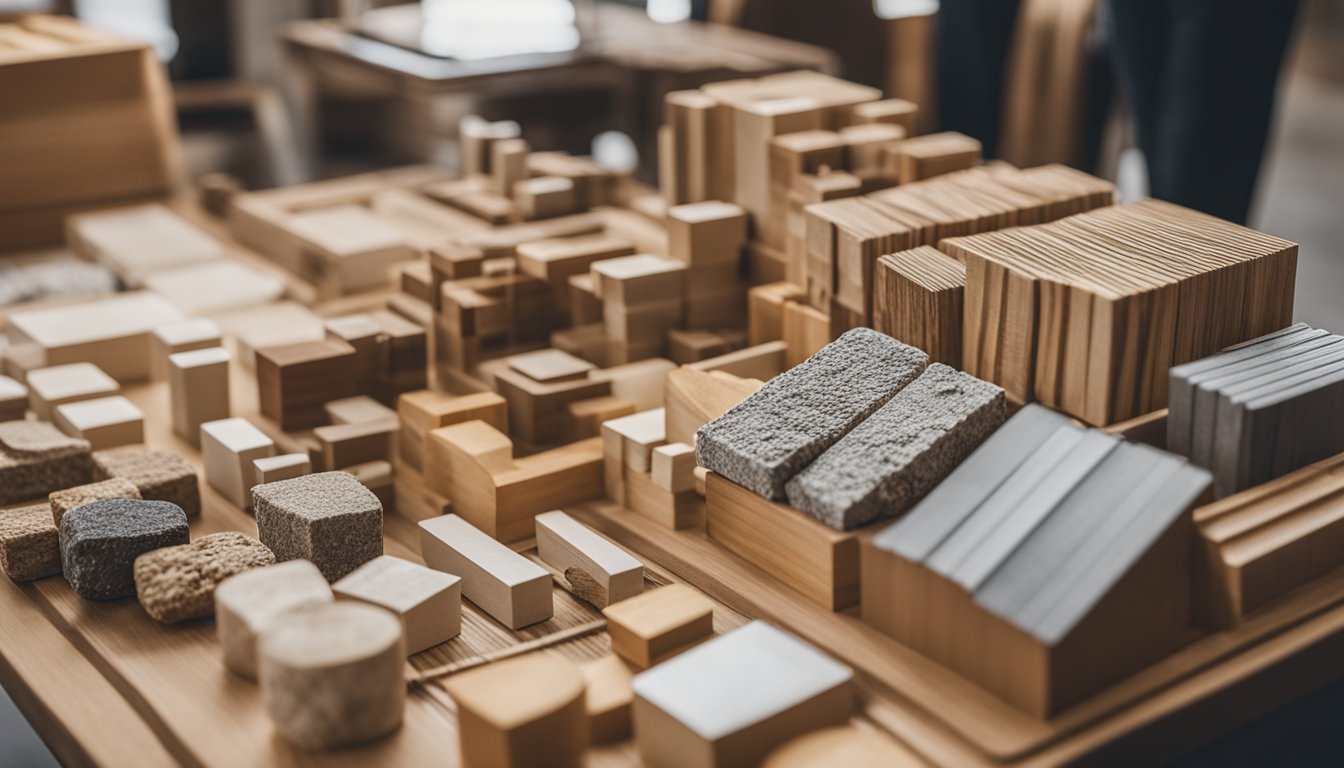Late updated: 06 Jan 2025 14:01
Written by: Eleanor Hartman
Guide To Selecting Sustainable Building Materials: Key Factors and Considerations
Sustainability is at the forefront of modern construction, influencing our choices in materials and design. As we aim to minimise the environmental impact of our buildings, selecting the right materials becomes crucial. Sustainable building materials are those that reduce harm to the environment and enhance the health and wellbeing of occupants. Our journey into the world of green construction offers insights and practical guidance for making informed choices.

Understanding what makes a building material sustainable involves considering several factors, such as life cycle impact, energy efficiency, and local sourcing. These considerations can significantly impact the environmental and economic outcomes of building projects. As we explore these dimensions, we hope to empower you with the knowledge to make choices that benefit both your project and the planet.
In the selection process, it’s essential to balance practical requirements with ecological considerations. We invite you to join us on this exploration, which not only promises to enlighten but also challenges us to rethink traditional building practices. Sustainable design is not just a trend but a responsibility we must embrace for a greener, healthier future.
Key Takeaways
- Sustainable materials enhance environmental and occupant health.
- Key factors include life cycle impact and local sourcing.
- Balancing practicality with ecology is vital in material selection.
Understanding Sustainable Building Materials
Our guide focuses on the critical components of sustainable building materials, examining their environmental impacts, and the certifications and standards that guide their use in construction. By understanding these facets, we can ensure the selection of materials that are not only eco-friendly but also resource-efficient and durable.
Defining Sustainability in Construction
Sustainability in construction revolves around selecting materials with minimal environmental impact, prioritising eco-friendly options. Sustainable building materials are chosen for their low carbon footprint and efficient use of natural resources.
Materials such as reclaimed wood, recycled metal, and insulation from renewable sources are prime examples. These materials not only reduce waste but also enhance sustainable architecture. By using green building materials, we contribute to resource efficiency, promoting a cradle to cradle lifecycle approach.
Durability is a crucial aspect, as it lowers the need for frequent replacements. By prioritising materials that last, we reduce the overall consumption of resources. Selecting the right materials is key to advancing our sustainability goals in the construction industry.
Evaluating Environmental Impacts
To assess environmental impacts, we perform a life cycle assessment (LCA) of building materials. This encompasses the entire journey of a material, from raw extraction to disposal or reuse, identifying areas where emissions and waste can be minimised.
The carbon footprint of materials is another focal point. Materials with lower carbon footprints are favoured, contributing to reduced greenhouse gas emissions. Implementing waste management practices further mitigates environmental impacts by ensuring that construction waste is recycled or disposed of responsibly.
Resource efficiency plays a major role too. By choosing materials that optimise resource use and reduce waste, we facilitate more sustainable architectural practices. The evaluation process aids in making informed decisions that reduce our environmental footprint effectively.
Certifications and Standards
Certifications like LEED (Leadership in Energy and Environmental Design) and the Forest Stewardship Council (FSC) provide frameworks for sustainable building practices. These standards authenticate the environmental responsibility and resource efficiency of building products.
LEED evaluates the environmental performance of a building, providing a benchmark for sustainable construction globally. Products with FSC certification ensure the wood comes from responsibly managed forests, promoting biodiversity and ecosystem health.
The Cradle to Cradle certification examines materials for renewability and potential recyclability, ensuring they can be returned to the earth safely. These certifications guide us towards consistent use of proven environmentally friendly materials, aligning our projects with best practices.
Selecting Materials for Sustainability

When aiming to select sustainable building materials, we focus on renewable resources, innovative green materials, energy efficiency, and enhancing indoor air quality. These choices not only support eco-friendly construction but also contribute to the cost-effectiveness of sustainable buildings.
Renewable and Recycled Content
Using materials with renewable and recycled content is central to constructing sustainable buildings. Bamboo is a perfect example; it grows quickly and regenerates after harvesting. Reclaimed wood offers another option, repurposing existing resources and reducing the demand for new timber. Certified wood from responsibly managed forests ensures long-term forestry sustainability.
Recycled metals and recycled steel are integral to structural elements, offering strength without requiring new raw materials. With innovations like ferrock and hempcrete, we harness by-products and industrial waste, creating eco-friendly alternatives with lesser carbon footprints. These steps effectively reduce waste and conserve natural resources.
Innovations in Green Materials
Eco-friendly materials continue to evolve, with mycelium and recycled plastic disrupting traditional construction methods. Mycelium, derived from fungi, provides a natural, biodegradable option that’s both strong and lightweight. This innovative material could soon replace less sustainable options in furnishing and insulation, representing a significant leap in green construction.
Recycled plastic offers versatility and durability, finding uses in everything from insulation to building blocks. Insulated concrete forms (ICFs), composed of recycled materials, further enhance construction energy efficiency, preserving heat and reducing the need for additional energy inputs. Integrating these materials into construction not only boosts sustainability but also supports the development of resilient structures.
Building for Energy Efficiency
Energy efficiency remains a cornerstone of sustainable building, and material selection plays a crucial role. By using insulation, we minimise energy waste, particularly in heating and cooling systems. Innovative methods, such as rammed earth, stabilise temperature fluctuations in buildings naturally, reducing energy needs.
Additionally, integrating solar panels into designs allows us to harness renewable energy directly. This reduces reliance on non-renewable sources and decreases the building’s carbon footprint. ICFs also contribute significantly by providing robust insulation that minimises thermal bridging. Selecting materials wisely in this context leads to substantial operational energy savings over the building's lifespan.
Improving Indoor Air Quality
Indoor air quality (IAQ) is critical when considering the occupants' health in sustainable construction. Focusing on low off-gassing materials is essential to mitigate harmful emissions. Recycled materials, when processed properly, ensure that indoor environments remain free from volatile organic compounds (VOCs).
Hempcrete is ideal for its natural ability to regulate humidity and absorb CO2, enhancing air quality. Using zero-VOC paints and finishes further improves IAQ, promoting a healthier space for inhabitants. Prioritising these selections not only improves occupant health but also aligns with broader sustainability goals by reducing potential environmental contaminants.
Frequently Asked Questions

Sustainable building materials are vital components of eco-friendly construction. Here, we address common queries about evaluating and selecting these materials, as well as design methods that support sustainability.
What factors should be considered when selecting materials for sustainable building?
When choosing sustainable building materials, we need to consider their life cycle impact, including their production, usage, and disposal. It is important to analyse energy efficiency, local availability, and their potential to reduce carbon emissions. Material durability and cost-effectiveness also play a significant role in sustainable selection.
How can one evaluate the sustainability of building materials?
Evaluating sustainability involves looking at the environmental impact of materials through their entire life cycle. Tools like Life Cycle Assessment (LCA) can provide insights into a material's ecological footprint. We should also consider certifications such as LEED or BREEAM, which ensure adherence to sustainable standards.
What are the seven essential elements for sustainable building design?
Sustainable building design incorporates seven key elements: energy efficiency, water conservation, indoor environmental quality, eco-friendly materials, waste reduction, sustainable site development, and innovation. By focusing on these areas, we can significantly minimise environmental impact and create resilient structures.
Which design methods promote sustainability in construction?
Design methods that promote sustainability include passive solar design, which maximises natural heating and lighting, and the use of renewable energy systems like solar panels. We should also implement green roofs and rainwater harvesting to enhance resource efficiency.
Can you provide examples of sustainable water management systems in building design?
Examples of sustainable water management systems include greywater recycling, which reuses wastewater for non-potable purposes, and rainwater harvesting systems that capture and store rainwater for later use. These systems can reduce water consumption and lessen the strain on municipal water supplies.
How does sustainable design contribute to the longevity of a business?
Sustainable design enhances a business's longevity by reducing operating costs and increasing energy efficiency. In addition, incorporating eco-friendly practices can improve brand reputation and customer loyalty. By investing in sustainability, businesses position themselves for long-term success and adaptability in a changing market.